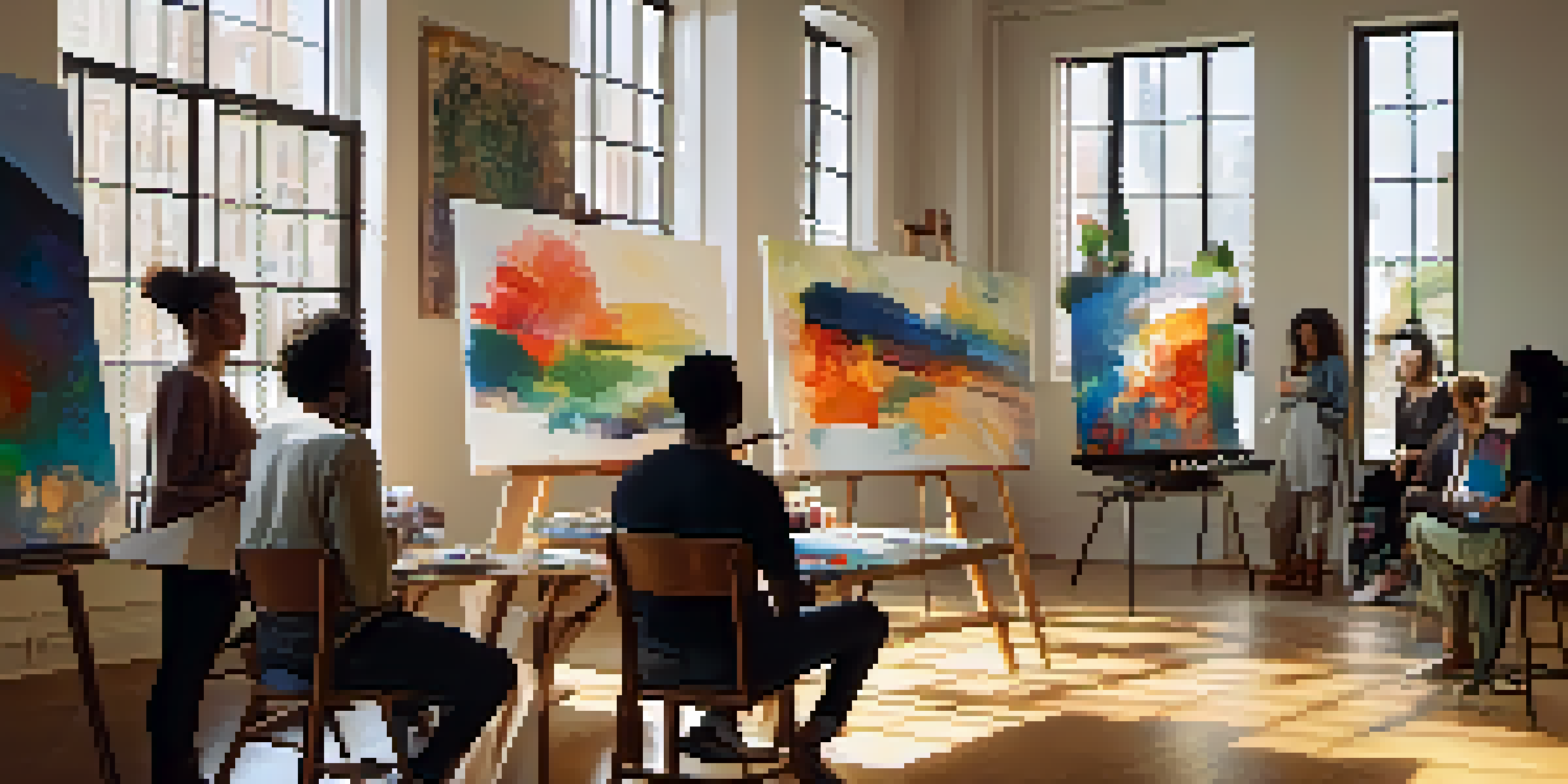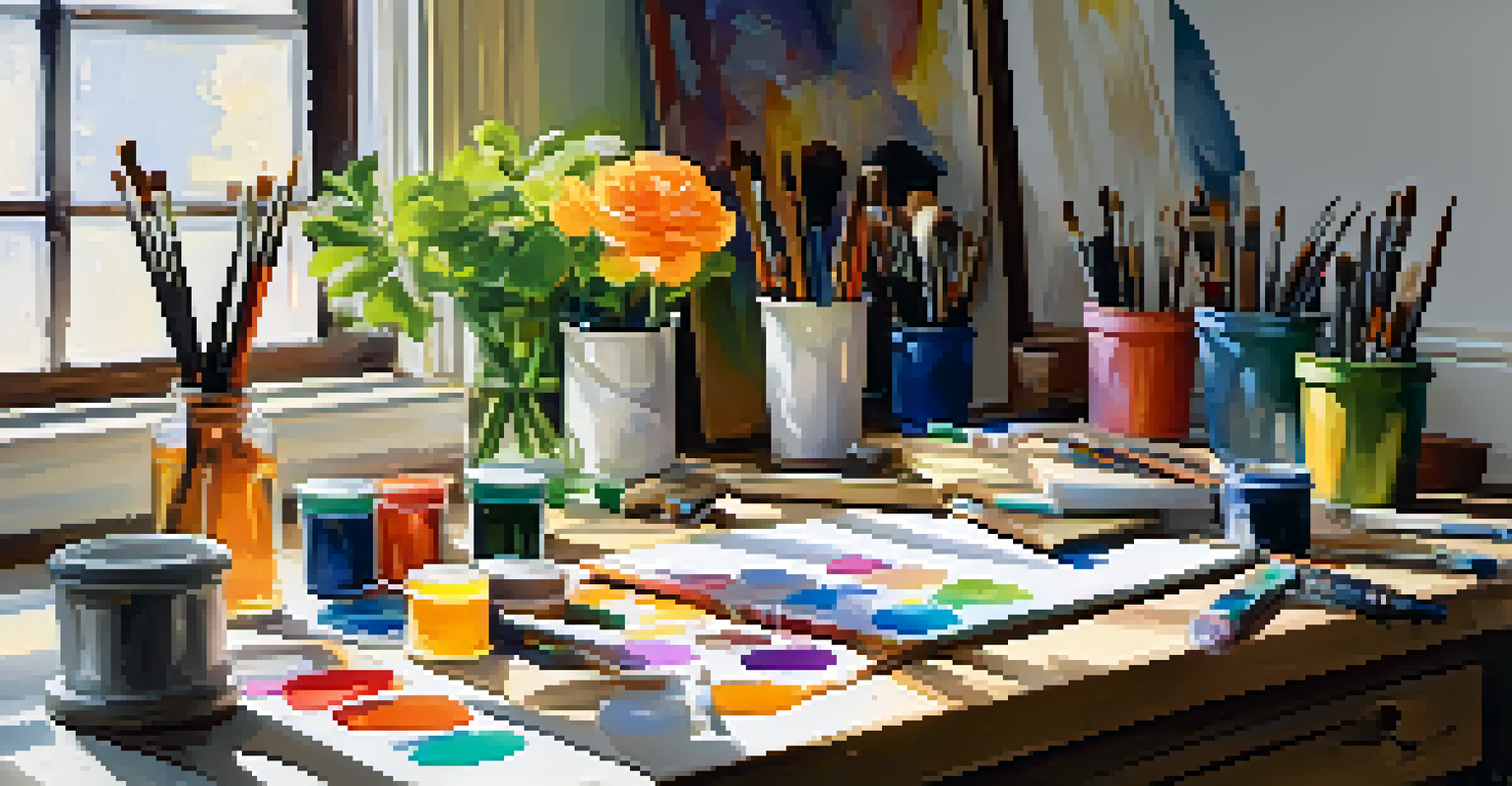Understanding Art Critique: A Guide for Beginner Painters

What is Art Critique and Why is it Important?
Art critique is the process of analyzing and discussing art to understand its elements and intentions. For beginner painters, engaging in critique can be an invaluable tool for growth and improvement. It helps you see your work from different perspectives, allowing you to refine your techniques and concepts.
Art is not freedom from discipline, but disciplined freedom.
Through critique, you gain insights not just about what works in your painting, but also about areas that may need more attention. This feedback loop can be the difference between stagnation and progress in your artistic journey. Understanding the importance of critique can empower you to seek constructive feedback rather than shy away from it.
Ultimately, art critique encourages a dialogue about creativity and expression. It fosters a community where artists can support each other, learn collectively, and push the boundaries of their work.
The Elements of Art: A Foundation for Critique
Before diving into critique, it's essential to understand the basic elements of art: line, shape, color, texture, and space. These elements serve as the building blocks of any painting, and recognizing them can help you articulate your thoughts during a critique. For instance, you might notice how the use of color impacts the mood of a piece.

When critiquing your own work or that of others, consider how these elements interact with one another. Are the colors harmonious, or do they clash? Is the composition balanced, or does it feel chaotic? By focusing on these foundational aspects, you can provide and receive more meaningful feedback.
Value of Art Critique for Growth
Engaging in art critique provides invaluable feedback that promotes artistic development and perspective.
This foundational knowledge not only enhances your ability to critique but also enriches your painting skills. As you become more aware of these elements, you can intentionally manipulate them in your own work to achieve desired effects.
Constructive vs. Destructive Critique: Finding Balance
Critique can take many forms, but the most beneficial is constructive feedback. Constructive critique is specific, actionable, and focuses on improvement, while destructive critique often feels personal and vague. As a beginner painter, learning to differentiate between the two can help you grow without feeling discouraged.
Every artist was first an amateur.
When receiving critique, look for comments that pinpoint specific strengths and weaknesses. For example, a comment like 'Your use of light creates depth' is constructive, whereas 'This painting is bad' is not helpful. Embrace feedback that guides you toward improvement and encourages experimentation.
On the flip side, when giving critique, aim to be supportive and clear. A well-rounded critique should highlight what works, suggest areas for improvement, and encourage further exploration. This balanced approach fosters a positive environment for all artists involved.
How to Prepare for an Art Critique Session
Preparation is key when it comes to art critique sessions. Before sharing your work, take a moment to reflect on your goals as an artist and what you hope to gain from the critique. This focus can guide both your feedback and the questions you ask during the session.
Consider providing context for your piece: what inspired it, the challenges you faced, and what you want viewers to feel. This background information can help others provide more targeted feedback that aligns with your intentions. Plus, it opens up a deeper conversation about your artistic choices.
Understanding Elements of Art
Familiarity with basic art elements enhances your ability to articulate critiques and improve your painting skills.
Lastly, approach the critique with an open mind. Remember that the feedback you receive is not a reflection of your worth as an artist but rather an opportunity for growth. Embrace the diverse perspectives that come your way, and don’t hesitate to ask questions for clarification.
The Role of Emotion in Art Critique
Art is inherently emotional, and understanding the emotional impact of a piece is crucial in critique. As a painter, consider the feelings you want to evoke in your audience, and be open to hearing how others perceive those emotions. This feedback can provide valuable insights into the effectiveness of your work.
When participating in critique, pay attention to the emotional responses that arise. Does a particular color or shape evoke joy, sadness, or confusion? Discussing these reactions can enhance your understanding of how your art communicates with viewers, allowing you to make more informed choices in future works.
At the same time, remember that art is subjective. While some may connect with your work, others may not. Embrace this diversity of opinion as a natural part of the creative process, and use it to inform your artistic evolution.
Incorporating Feedback into Your Practice
Receiving feedback is only half the battle; the real challenge lies in how you incorporate it into your practice. After a critique session, take time to reflect on the comments made and identify which pieces of advice resonate with you most. Not all feedback will align with your vision, and that’s okay.
One effective strategy is to create a list of actionable items based on the feedback you received. For instance, if several people mention that your composition feels crowded, you might decide to experiment with negative space in your next piece. This approach transforms critique into a practical roadmap for improvement.
Building Community Through Critique
Participating in art critique fosters connections with fellow artists, offering support and inspiration throughout your creative journey.
As you implement changes, keep a journal of your artistic journey. Documenting your progress will not only help you track your growth but also serve as a reminder of the lessons learned from critique. Over time, you’ll find that this process becomes a natural part of your artistic practice.
Finding Community Through Art Critique
Engaging in art critique can be a powerful way to connect with fellow artists and build a supportive community. Whether you join a local art group, participate in online forums, or attend workshops, sharing your work and receiving feedback creates bonds with others who understand the creative journey. These relationships can be invaluable in your growth as a painter.
A strong community can provide encouragement, motivation, and a sense of belonging. When you share your struggles and successes with others, you realize that you’re not alone in your artistic endeavors. This camaraderie can inspire you to take risks and push your boundaries in your work.

Additionally, being part of an artistic community opens doors to new opportunities for collaboration and learning. You might discover new techniques, styles, or perspectives that you hadn't considered before. Embrace the connections you make through critique, and let them enhance your artistic journey.